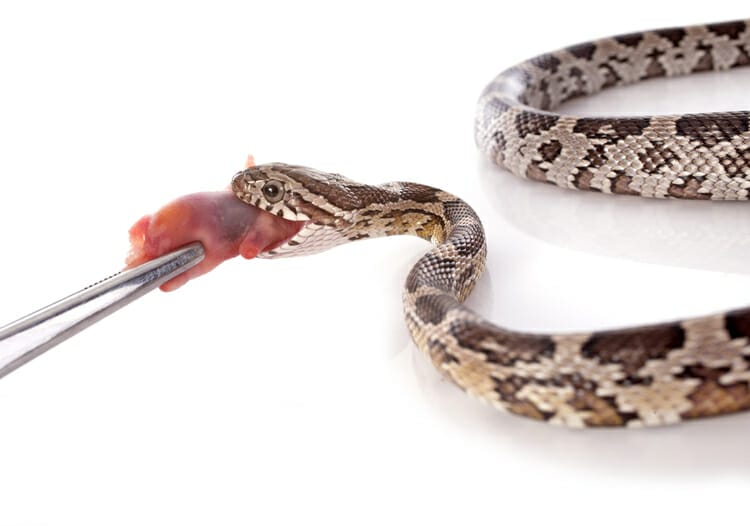Baby rat snakes are born with a voracious appetite. They will devour anything small enough to fit into their mouths.
Baby rat snakes are carnivores and hunt their prey and kill by constriction. They eat mice, gerbils, rats, amphibians, birds, eggs, and even other small mammals. However, baby snakes have a slow metabolism and need only eat once every 4–5 days.
Rat Snakes are among the most common pet snakes in the United States. And they’re also pretty easy to take care of.
In this article, you will find everything you need to know about what they eat in the wild and in captivity with feeding tips.
So let’s begin.
What do Baby Rat Snakes Eat?

In North America alone, there are over 30 different species of rat snakes and an uncountable number of subspecies, which vary in color and size depending on the region they live in.
The three most common types of rat snakes that you’ll see in captivity or nature. Those are Corn Snake (Elaphe guttata), Black Rat Snake (Elaphe obsoleta), and Gray Rat Snake (Elaphe quadrivittata). However, they have nearly similar food habits.
Baby rat snakes are very small, delicate creatures. When they are born, they are roughly 2–3 inches long. The baby rat snake’s diet is very similar to that of adults. The only difference is that they eat smaller and softer prey.
Now, If you’re wondering what baby rat snakes eat, here’s a list of foods they eat as babies.
- Rat
- Mice
- Voles
- Amphibians
- Birds
- Eggs
- Small Lizard
- Frogs
- Chicks
- Insects
- Baby rabbits, etc.
Baby Rat Snakes Food Habit in Wild
The baby rat snake is a nocturnal reptile. It inhabits forests, fields, agricultural land with plenty of cover like shrubs, rocks, debris piles, etc. In other words, rat snakes usually reside in areas with plenty of vegetation.
It generally likes to eat toads, frogs, birds, and rats in its natural habitat.
The adults are good hunters because they can catch their prey underground. But, as their name implies, they mostly hunt rodents.
The young ones, on the other hand, eat smaller prey such as insects and worms. This is easier for them because they are not that strong yet.
Moreover, they also feed on invertebrates like centipedes and millipedes in some cases.
What to Feed Pet Baby Snakes?

This is not a good beginner snake for people that want an easy snake to take care of. These snakes are high maintenance because of their feeding requirements and their size once they reach adulthood.
Their diet must be made up of whole rats or other large rodents to grow quickly. Besides, to keep them happy and healthy, you must first learn about their feeding requirements.
When you’re raising baby rat snakes in captivity, be sure to feed them a proper diet that includes rodents such as mice and baby rats. You may also try insects such as crickets, mealworms, earthworms, butter worms, nightcrawlers, as well as small lizards such as anoles and geckos.
If you cannot offer them live prey, you can serve your baby rat snake frozen rodents and thawed mice as a substitute. Although baby rats, snakes prefer freshly killed warm food.
Tips on Feeding
- The only thing that needs to be avoided is any bones or eggshells. That could break off inside your baby snake’s digestive tract causing internal blockages or cuts in their intestines.
- Rat snakes are venomous, use constriction to kill their prey. However, the newborn might find it hard to kill. So, provide insects or frozen rats.
- Though a healthy diet is important for their growth, overfeeding may develop digestion problems or exhibit unhealthy growth.
- Besides, make sure to feed every four to five days for growing baby rat snakes.
Baby snakes grow very fast, so you must always supply enough prey items to keep them healthy and growing.
Even one that isn’t venomous, a new baby snake, is just as dangerous as a bigger snake. So, keep an eye on your fingers! A new baby rattlesnake will be nervous and defensive of its territory. It may bite out of fear if it feels threatened or startled.


You May Also Read